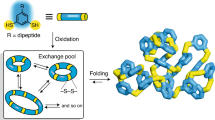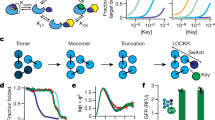Abstract
The biological function of biomacromolecules such as DNA and enzymes depends on their ability to perform and control mo-lecular association, catalysis, self-replication or other chemical processes. In the case of proteins in particular, the dependence of these functions on the three-dimensional protein conformation is long known1 and has inspired the development of synthetic oligomers and polymers with the capacity to fold in a controlled manner2,3,4,5,6,7, but it remains challenging to design these so-called ‘foldamers’ so that they are capable of inducing or controlling chemical processes and interactions8,9. Here we show that the stability gained from folding can be used to control the synthesis of oligomers from short chain segments reversibly ligated through an imine metathesis reaction. That is, folding shifts the ligation equilibrium10,11,12,13 in favour of conformationally ordered sequences, so that oligomers having the most stable solution structures form preferentially. Crystallization has previously been used to shift an equilibrium in order to indirectly influence the synthesis of small molecules14, but the present approach to selectively prepare macromolecules with stable conformations directly connects folding and synthesis, emphasizing molecular function rather than structure in polymer synthesis.
This is a preview of subscription content, access via your institution
Access options
Subscribe to this journal
Receive 51 print issues and online access
$199.00 per year
only $3.90 per issue
Buy this article
- Purchase on Springer Link
- Instant access to full article PDF
Prices may be subject to local taxes which are calculated during checkout



Similar content being viewed by others
References
Mirsky, A. E. & Pauling, L. On the structure of native, denatured, and coagulated proteins. Proc. Natl Acad. Sci. USA 22, 439–447 (1936).
Gellman, S. H. Foldamers: A manifesto. Acc. Chem. Res. 31, 173–180 (1998).
Nowick, J. S. Chemical models of protein β-sheets. Acc. Chem. Res. 32, 287–296 (1999).
Katz, T. J. Syntheses of functionalized and aggregating helical conjugated molecules. Angew. Chem. Int. Edn Engl. 39, 1921–1923 (2000).
Nelson, J. C., Saven, J. G., Moore, J. S. & Wolynes, P. G. Solvophobically driven folding of nonbiological oligomers. Science 277, 1793–1796 (1997).
Hirschberg, J. H. K. K. et al. Helical self-assembled polymers from cooperative stacking of hydrogen-bonded pairs. Nature 407, 167–170 (2000).
Berl, V., Huc, I., Khoury, R. G., Krische, M. J. & Lehn, J.-M. Interconversion of single and double helices formed from synthetic molecular strands. Nature 407, 720–723 (2000).
Kirshenbaum, K., Zuckermann, R. N. & Dill, K. A. Designing polymers that mimic biomolecules. Curr. Opin. Struct. Biol. 9, 530–535 (1999).
Stigers, K. D., Soth, M. J. & Nowick, J. S. Designed molecules that fold to mimic protein secondary structures. Curr. Opin. Chem. Biol. 3, 714–723 (1999).
Lehn, J.-M. & Eliseev, A. V. Dynamic combinatorial chemistry. Science 291, 2331–2332 (2001).
Lehn, J.-M. Dynamic combinatorial chemistry and virtual combinatorial libraries. Chem. Eur. J. 5, 2455–2463 (1999).
Huc, I. & Lehn, J.-M. Virtual combinatorial libraries: Dynamic generation of molecular and supramolecular diversity by self-assembly. Proc. Natl Acad. Sci. USA 94, 2106–2110 (1997).
Moore, J. S. & Zimmerman, N. W. “Masterpiece” copolymer sequences by targeted equilibrium-shifting. Org. Lett. 2, 915–918 (2000).
Woodward, R. B., Sondheimer, F., Taub, D., Heusler, K. & McLarmore, W. M. The total synthesis of steroids. J. Am. Chem. Soc. 74, 4223–4251 (1952).
Trost, B. M. The atom economy—A search for synthetic efficiency. Science 254, 1471–1477 (1991).
Tóth, G., Pintér, I. & Messmer, A. Mechanism of the exchange reaction of aromatic Schiff bases. Tetrahedr. Lett. 15, 735–738 (1974).
Prince, R. B., Saven, J. G., Wolynes, P. G. & Moore, J. S. Cooperative conformational transitions in phenylene ethylnylene oligomers: Chain-length dependence. J. Am. Chem. Soc. 121, 3114–3121 (1999).
Pace, C. N., Shirley, B. A. & Thomson, J. A. in Protein Structure: A Practical Approach (ed. Creighton, T. E.) 311–330 (IRL, New York, 1989).
Goodman, M., Verdini, A. S., Toniolo, C., Phillips, W. D. & Bovey, F. A. Sensitive criteria for the critical size for helix formation in oligopeptides. Proc. Natl Acad. Sci. USA 64, 444–450 (1969).
Zhang, J., Pesak, D. J., Ludwick, J. L. & Moore, J. S. Geometrically-controlled and site-specifically-functionalized phenylacetylene macrocycles. J. Am. Chem. Soc. 116, 4227–4239 (1994).
Acknowledgements
We thank C. F. Zukoski and A. Y. Mirarefi for discussions and comments on light-scattering experiments. This work was supported by the National Science Foundation and the US Department of Energy, Division of Materials Sciences, through the Frederick Seitz Materials Research Laboratory at the University of Illinois at Urbana-Champaign.
Author information
Authors and Affiliations
Corresponding author
Ethics declarations
Competing interests
The authors declare no competing financial interests.
Supplementary information
41586_2001_BF414889a_MOESM2_ESM.pdf
Solvent denaturation, CD and molecular modeling of imine dodecamer 3e and imine metathesis for folding-driven synthesis of oligomers (PDF 41 kb)
41586_2001_BF414889a_MOESM3_ESM.pdf
Theoretical consideration of the segment selection and the driving force of the equilibrium shifting for folding-driven systems of oligomers (PDF 142 kb)
Rights and permissions
About this article
Cite this article
Oh, K., Jeong, KS. & Moore, J. Folding-driven synthesis of oligomers. Nature 414, 889–893 (2001). https://doi.org/10.1038/414889a
Received:
Accepted:
Issue Date:
DOI: https://doi.org/10.1038/414889a
This article is cited by
-
Complexation-driven assembly of imine-linked helical receptors showing adaptive folding and temperature-dependent guest selection
Nature Communications (2024)
-
Emergence of low-symmetry foldamers from single monomers
Nature Chemistry (2020)
-
Autonomous helical propagation of active toroids with mechanical action
Nature Communications (2019)
-
Dynamic control of chirality and self-assembly of double-stranded helicates with light
Nature Chemistry (2017)
-
Enzyme-assisted self-assembly under thermodynamic control
Nature Nanotechnology (2009)
Comments
By submitting a comment you agree to abide by our Terms and Community Guidelines. If you find something abusive or that does not comply with our terms or guidelines please flag it as inappropriate.



